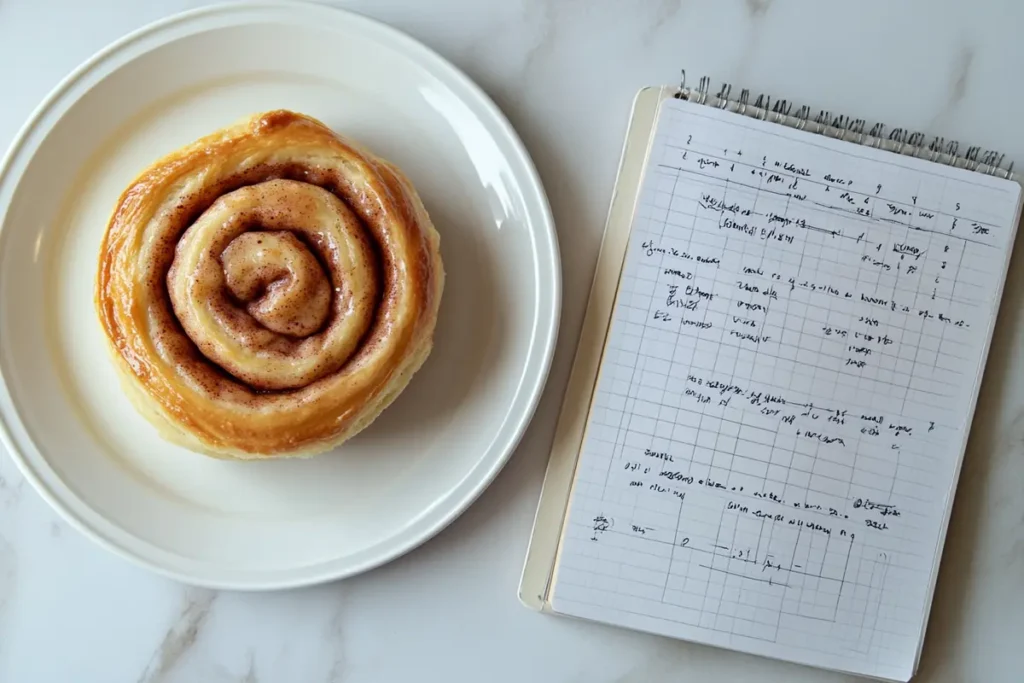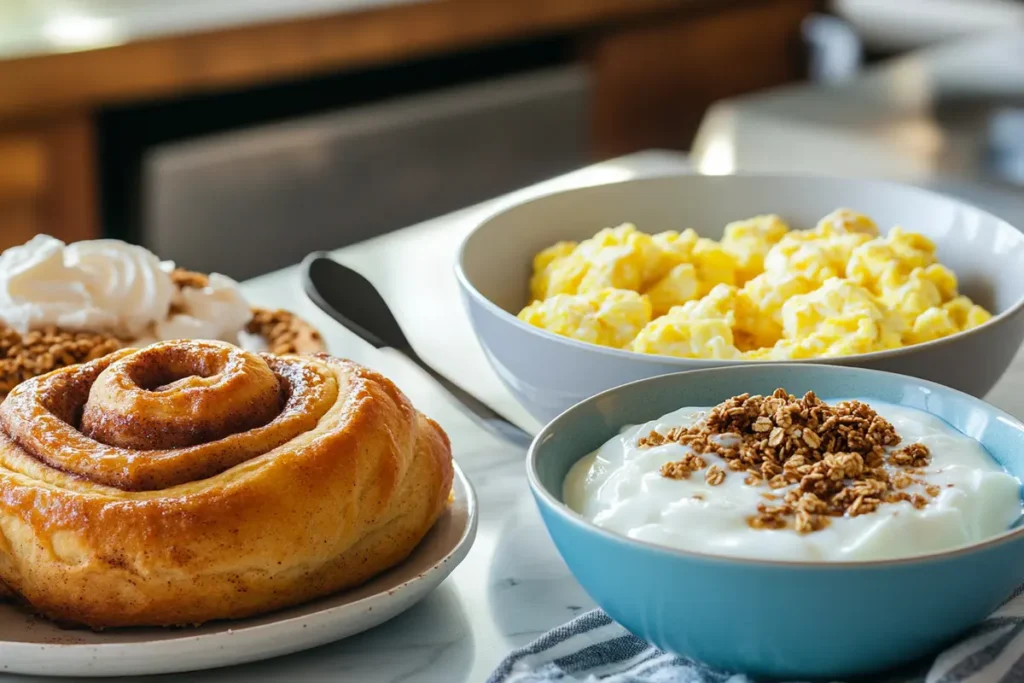Cinnamon roll for breakfast it’s a tantalizing question, isn’t it? This beloved pastry, with its sweet, sticky layers and aromatic spices, is undeniably a favorite. But is it a good choice to start your day? This article dives deep into the nutritional makeup of cinnamon rolls, their pros and cons, and even explores healthier alternatives. Whether you’re a cinnamon roll lover or just curious, you’re in for an eye-opening read.
Table of Contents
Introduction and Overview
What Are Cinnamon Rolls?
Cinnamon rolls are a classic treat known for their rich aroma and comforting sweetness. Originating in Northern Europe, these spiraled pastries are typically made with enriched dough, butter, sugar, and, of course, cinnamon. Baked to golden perfection and often drizzled with a creamy glaze, they’re a popular breakfast indulgence around the globe.
The process of making cinnamon rolls involves rolling out a soft dough, spreading it with butter, sprinkling a mix of sugar and cinnamon, then rolling it up and slicing it into spirals. Whether served fresh from the oven or reheated the next day, their warm, gooey texture is nothing short of delightful.
Overview: Are Cinnamon Rolls Good for Breakfast?
When evaluating whether a cinnamon roll is good for breakfast, we need to look at both sides of the coin. Breakfast, as the first meal of the day, should ideally provide energy, nutrients, and satiety. While cinnamon rolls offer a quick energy boost, their high sugar and calorie content raise questions about their suitability as a regular breakfast choice.
In this article, we’ll explore:
- The nutritional profile of cinnamon rolls.
- Their impact on energy and health.
- The pros and cons of making them your morning go-to.
- Healthier ways to enjoy cinnamon rolls without sacrificing taste.
Nutritional Profile of Cinnamon Rolls
What Is in a Typical Cinnamon Roll?
A typical cinnamon roll might seem like a simple pastry, but its ingredients pack a surprising nutritional punch—both good and bad. On average, a single cinnamon roll contains approximately:
- Calories: 300–500, depending on size and toppings.
- Sugar: 15–30 grams, mostly from the glaze and filling.
- Carbohydrates: 50–70 grams, offering a quick energy source.
- Fats: 10–20 grams, primarily from butter in the dough and filling.
- Protein: A modest 4–7 grams, insufficient for sustained energy.
While the combination of sugar and carbs provides an instant energy spike, it lacks the long-lasting benefits of proteins and fibers that keep you feeling full.

Are Cinnamon Rolls Healthy?
From a nutritional standpoint, cinnamon rolls are more indulgence than sustenance. The high sugar and saturated fat content can contribute to weight gain and increased cholesterol levels if consumed regularly. They offer minimal vitamins, minerals, or fiber, which are essential components of a balanced diet.
However, it’s not all bad news. Cinnamon, the key spice, has antioxidant and anti-inflammatory properties. A sprinkle of cinnamon on your breakfast roll might not undo the negatives, but it’s a tiny silver lining in this sugary cloud.
Impact of Sugar and Carbs in Cinnamon Rolls
The large amounts of sugar in a cinnamon roll have an immediate effect on your blood sugar levels. After eating one, your energy might soar momentarily, but that’s usually followed by a dramatic crash, leaving you lethargic or craving more sweets. Additionally, diets high in refined sugar and carbs can lead to:
- Weight gain.
- Increased risk of type 2 diabetes.
- Dental problems like cavities.
For those managing blood sugar levels, like diabetics, cinnamon rolls for breakfast might not be the best choice.
How Cinnamon Rolls Compare to Other Breakfast Foods
Let’s see how cinnamon rolls stack up against other popular breakfast options:
| Breakfast Food | Calories | Protein | Sugar | Fiber |
|---|---|---|---|---|
| Cinnamon Roll | 350–500 | 4–7g | 15–30g | <2g |
| Bagel with Cream Cheese | 250–300 | 9–12g | 5–7g | 2–3g |
| Pancakes with Syrup | 400–600 | 6–8g | 20–35g | 1–2g |
| Oatmeal with Fruit | 150–250 | 5–7g | 5–15g | 3–5g |
Cinnamon rolls are among the highest in sugar and calories, yet lowest in protein and fiber a clear sign they may not be ideal as an everyday breakfast.
The Pros and Cons of Eating Cinnamon Rolls for Breakfast
The Pros of Eating Cinnamon Rolls for Breakfast
Let’s not sugarcoat it cinnamon rolls for breakfast have some undeniable perks (pun intended). While they might not be the most nutritious option, they bring certain advantages to the table:
- Quick and Convenient: Whether store-bought or pre-made, cinnamon rolls are a hassle-free morning treat. Pop one in the microwave, and voilà you’ve got a warm, ready-to-eat breakfast in minutes.
- Comfort Food: The sweet aroma and soft, gooey texture provide a comforting start to the day, especially during chilly mornings or festive seasons.
- Great for Special Occasions: From Sunday brunches to holiday mornings, cinnamon rolls shine as a celebratory breakfast item. They’re indulgent enough to make ordinary days feel special.
The Cons of Eating Cinnamon Rolls for Breakfast
As delightful as they are, cinnamon rolls come with their share of drawbacks, particularly when it comes to their nutritional value:
- High in Sugar and Calories: The typical cinnamon roll is loaded with sugar, often exceeding 25 grams per serving, which is nearly the daily recommended limit for some adults. Over time, this can lead to weight gain, tooth decay, and even metabolic disorders.
- Lack of Sustained Energy: Without enough protein or fiber, a cinnamon roll is digested quickly, leading to an energy crash mid-morning. You may find yourself hungry again within an hour or two.
- Limited Nutritional Benefits: While they’re undeniably tasty, cinnamon rolls don’t offer the vitamins, minerals, or fiber necessary for a balanced breakfast.
Who Should Avoid Cinnamon Rolls in the Morning?
While cinnamon rolls can be an occasional treat, certain groups should think twice about indulging in them first thing in the morning:
- Diabetics: The high sugar content can cause dangerous blood sugar spikes.
- Those on Weight Loss Diets: Cinnamon rolls are calorie-dense and can hinder weight management goals.
- People with Digestive Issues: The refined carbs and lack of fiber can exacerbate bloating or digestive discomfort.
How Cinnamon Rolls Fit Into a Balanced Breakfast
Enjoying a cinnamon roll for breakfast doesn’t mean your entire morning meal has to be nutritionally void. You can pair it with protein or fiber-rich foods to balance out the sugar and carb content:
- Protein: Add scrambled eggs, Greek yogurt, or a handful of nuts to increase satiety.
- Fiber: Serve your cinnamon roll with a side of fresh fruit, such as berries or sliced apples, to promote better digestion.
- Healthy Fats: Include a slice of avocado or a drizzle of almond butter for longer-lasting energy.
By incorporating these additions, you can transform your indulgence into a more balanced meal.

Transitioning to a Balanced Breakfast
Understanding the pros and cons of cinnamon rolls allows you to enjoy them thoughtfully. With some adjustments, they can be part of a satisfying breakfast on special occasions rather than an everyday habit.
Healthier Alternatives and Customizations
Making Cinnamon Rolls Healthier
For those who can’t resist a cinnamon roll for breakfast, tweaking the recipe can make a big difference in its nutritional profile. By making these small changes, you can enjoy the same flavors with less guilt:
- Use Whole-Grain Flour: Swap all-purpose flour with whole-grain or spelt flour to boost fiber content and improve digestion.
- Reduce Sugar: Cut down on the sugar in both the dough and the glaze. A touch of natural sweeteners like honey or maple syrup can provide sweetness without the spike.
- Add Healthy Mix-Ins: Incorporate nuts, seeds, or dried fruit for added texture, protein, and essential nutrients.

Alternatives to Traditional Cinnamon Rolls
If you’re open to trying something new, there are plenty of healthier alternatives that mimic the flavors of cinnamon rolls without the heavy sugar and calories:
- Gluten-Free Cinnamon Rolls: Perfect for those with gluten sensitivities, these use almond or oat flour as a base.
- Vegan Cinnamon Rolls: Skip the butter and eggs and use plant-based substitutes like coconut oil and almond milk.
- Protein-Packed Cinnamon Rolls: Enhance the recipe with protein powder or Greek yogurt for a breakfast that fuels your muscles and keeps you full longer.
Customizing Store-Bought Cinnamon Rolls
Not in the mood to bake? No problem! With a few clever hacks, you can upgrade store-bought cinnamon rolls:
- Add Fresh Toppings: Sprinkle chopped nuts or fresh berries on top to increase texture and nutritional value.
- Pair with Protein: Serve with a boiled egg or a small serving of smoked salmon to add balance.
- Opt for Mini Rolls: Choose smaller portions to control calorie intake while still enjoying the treat.
Recipes for Healthy Cinnamon Roll-Inspired Breakfasts
For a healthier take, why not try cinnamon roll-inspired dishes that incorporate the same warm flavors?
- Cinnamon Roll Oatmeal: Combine rolled oats with cinnamon, a drizzle of honey, and a swirl of almond butter for a comforting breakfast bowl.
- Cinnamon Roll Smoothie: Blend bananas, Greek yogurt, cinnamon, and a splash of almond milk for a drinkable version of your favorite pastry.
- Cinnamon Roll Pancakes: Whip up whole-grain pancakes with a swirl of cinnamon sugar baked in for a decadent yet lighter morning treat.
FAQs Section
Are Cinnamon Rolls Considered a Junk Food?
Yes, cinnamon rolls are generally categorized as junk food due to their high sugar, fat, and calorie content. While delicious, they lack essential nutrients like fiber, vitamins, and minerals, making them more of an indulgent treat than a balanced breakfast option.
How Many Calories Are in a Cinnamon Roll?
A typical cinnamon roll contains between 300 to 500 calories, depending on its size and ingredients. Larger, bakery-style rolls with cream cheese frosting can even exceed 600 calories. This high calorie count primarily comes from sugar, butter, and refined flour.
Can Cinnamon Rolls Be Part of a Healthy Diet?
Yes, but moderation is key. Cinnamon rolls can fit into a healthy diet as an occasional treat, especially when paired with protein-rich and fiber-dense foods to balance their sugar content. Opting for smaller portions or healthier homemade versions can also help.
What Can I Eat With a Cinnamon Roll to Make It a Balanced Meal?
Pairing a cinnamon roll for breakfast with protein or fiber-rich foods can make it more balanced. Suggestions include:
- A hard-boiled egg or scrambled eggs.
- A handful of nuts or seeds.
- Fresh fruits like berries or apple slices.
- A small serving of Greek yogurt.
Are There Healthier Store-Bought Cinnamon Rolls?
Yes, some brands offer healthier options, such as whole-grain or reduced-sugar cinnamon rolls. Look for rolls with lower sugar content, fewer artificial ingredients, and higher fiber levels. Always check the nutrition label before purchasing.
How Often Should I Eat Cinnamon Rolls?
Cinnamon rolls are best enjoyed occasionally rather than daily. Their high sugar and calorie content make them more suitable as a weekend treat or special occasion breakfast. Regular consumption can lead to weight gain and other health issues.
Conclusion
Summarizing Key Points
Cinnamon rolls, with their sweet, aromatic appeal, have earned their place as a popular breakfast choice. However, their high sugar, refined carbs, and calorie content make them less suitable as an everyday option. While they provide a quick energy boost, they lack the nutrients needed for a balanced start to the day.
From examining their nutritional profile to exploring the pros and cons of cinnamon rolls, it’s clear that moderation is key. While they can occasionally fit into a healthy diet, making mindful adjustments like pairing them with protein-rich foods or exploring healthier recipes can go a long way.
Final Thoughts: Are Cinnamon Rolls Good for Breakfast?
So, is a cinnamon roll good for breakfast? The answer lies in balance. While they may not be the healthiest choice, they’re undeniably delicious and can be enjoyed as a treat or on special occasions. With the right pairings or by opting for healthier versions, you can indulge in their sweetness without compromising your nutritional goals.
By making informed choices and embracing moderation, you can have the best of both worlds a delicious cinnamon roll and a healthier lifestyle. Now, isn’t that a sweet deal?

